Dead Man’s Hand Design Document
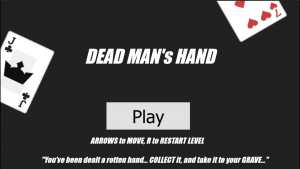 Overall Vision
Overall Vision
- Summary. In Dead Man’s Hand, you must navigate levels and collect a hand (score) of 21 before reaching the exit. A power up is hidden throughout each level to help you on your way, and enemy hell hounds guard the areas you must travel through. Once you reach a score of 21, a powerful enemy appears and pursues you until you reach the exit.
- Genre. This game is a horror puzzle-platformer. The enemies and environments of this game are dark, and while the player navigates the levels with standard platforming controls, they must also discover the secret to escaping the levels by learning that they must get a hand of 21.
- Target Audience. The target audience for this game is young adults or teens — younger children may not have the knowledge of card games needed to solve the central puzzle of the game.
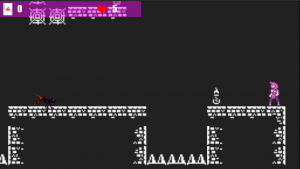
Mechanics
- Character Goals. The character’s goal in this game is to escape the casino of the dead by winning at Blackjack.
- Abilities. Initially, the character has very few abilities save for her wits. She can defeat the hell hounds that roam the casino, but not the reaper that eventually comes to claim her soul. If she finds the boots hidden in each level then she can double jump, which will help her navigate levels more quickly and avoid the reaper.
- Obstacles. There are several endless pits and spikes that will instantly defeat the character should she fall into them. In addition to this, and the jumping puzzles required to navigate the levels, there are two different kinds of enemies that she must face. Hell hounds patrol sections of the level, and can be defeated, if the player is comfortable taking some damage. After the player gains a hand of 21, the reaper appears, and attempts to defeat the character before they can reach the exit. The reaper moves slowly, but deals a large amount of damage and cannot be defeated.
- Items. The two main items throughout the game are cards, and the boots. Cards are necessary for raising the player’s score to 21 so that they can escape their current level — too high or low, and they merely restart the same level. The boots are necessary for easily navigating each level, as they allow the player to double jump. Without them, the player will have a much more difficult time evading enemies and landing on the correct platforms.
- Resources. The player has two main resources to manage: health, and their card score. If their health reaches zero, they lose the game. The goal of each level is to reach the exit after achieving a score of 21 — this means that once they achieve this number, they cannot afford to collect any more cards.
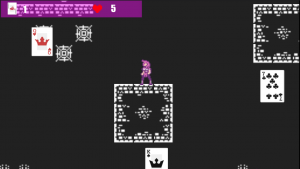
Dynamics
- User Interaction. A player needs a computer in order to play Dead Man’s Hand. The arrow keys are the main interface for the player, as well as the “R” key, which resets the player in their current level — this helps them in case they accidentally gain too many cards. The controls are communicated on the start page of the game. The user begins the game with a mouse click on the title page of the game.
- Proficiency. A player must become proficient in the floaty physics of the player character in order to beat the game, as well as be able to remember where certain cards are located and be able to move quickly under pressure once the reaper appears.
- Gameplay Data. The only data made visible to the player is their card score and their health, both of which are located in a UI in the top left of the screen. Once the player’s hand reaches at least 21, the text of the score turns gold, informing them that they can now successfully utilize the exit, and that the reaper has appeared.
- Controlling the game. The user can reset the level of the game that they are on through the use of the R button. They can start the game though clicking on the play button with the left mouse button.
Aesthetics
- Overall. The style of this game is based on older pulpy-horror games such as the early Castlevania titles. The game is meant to be difficult and spooky — why would demons give you an easy time?
- Game Art. The game utilizes primarily pixel art, with the exception of the cards — this is for the sake of clarity, so that they player can better know which cards they are currently about to collect. The monochrome levels are meant to help the player better recognize cards and threats, as well as emphasize the spooky dreariness of the setting.
- Sound. Background music is not utilized, as any sort of chiptune music tended to drown out the more helpful sound effects. Sound effects were utilized for power ups, item collecting, damage, and jumping.
- Plot. In Dead Man’s Hand, a spunky young lady has found her way into the Casino of the Dead. She must have the perfect Blackjack hand of 21 to escape — but the spirits and demons who occupy the casino don’t like to play fair.
- Emotional State. The state that the game intends to invoke in the player is a frustration that evolves into satisfaction as the player begins to locate items and understand what they must do.
- Fun. This game is meant to be challenging — initially, it may seem unfair, especially if they do not understand that they are supposed to have a score of exactly 21. However, as the player begins to locate where different items are located, they will become more and more capable throughout the game until they are able to beat it, leading to a sense of accomplishment that would be less present in an easier game.
Credits
The 1-bit environment tiles, as well as the card icons, were created by “Kenney”, the Netherlands-based game design studio. The sprites for the reaper and the hell hound, as well as the sound effects for the game, were made by the itch.io user “ansimuz”, who has a portfolio filled with excellent pixel art and assets. The player character sprite was created by “Red Rage Mage”, who also has many clever creations on itch.io.
Reflection
All said and done, I had a great time creating this game, once I settled on the “Blackjack” angle of the levels. Initially, I had attempted to anchor enemies to the UI layer instead of the level, and have them attack the player more often the more mistakes they made in the level — this quickly proved to not only take a lot of coding, but also be incredibly difficult and absolutely not fun. Wanting to retain a spooky theme, I decided that a system of needing a precise score would add a challenge without being quite so insurmountable — and thus, Dead Man’s Hand was born.
My only real regrets about this project was how stubborn I was when I was collecting assets — I very much was married to the thought of having a 1-bit, monochrome, old-school Mac style of game. I found the tileset for that aesthetic, but other assets were not quite as forthcoming. What was more challenging though is that my tileset was incredibly tiny, and I had to make the size of my game incredibly small. While ultimately I believe that this made me design my levels with a bit more forethought, it would have been much easier to design my game and size my assets appropriately if I had more space to work with without distorting my background. My favorite aspect of this game was designing the reaper — figuring out how to successfully have an enemy haunt the player at an appropriately intimidating speed took some thinking to implement, and was satisfying to get right.
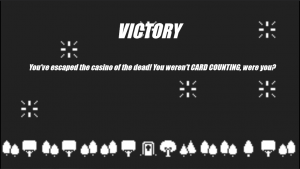
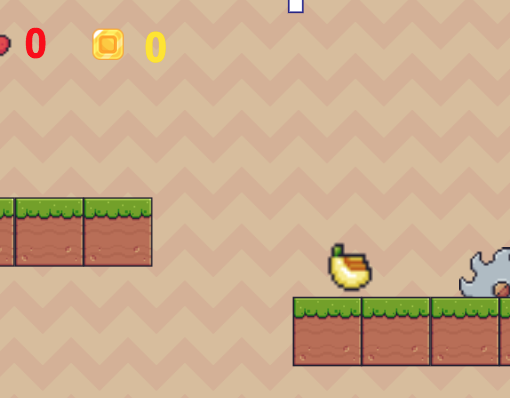

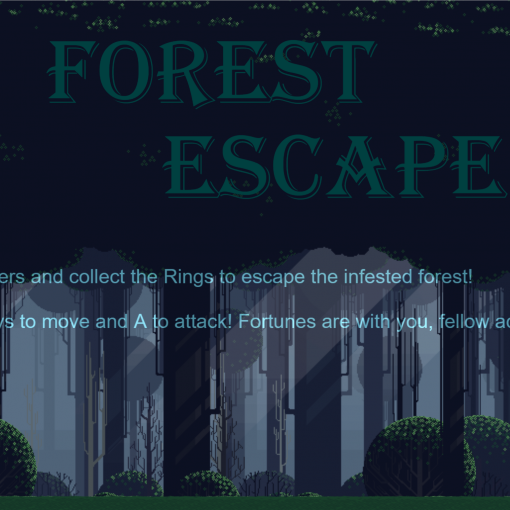

Leave a Reply